Scottish Power: Financial Performance, Key Decisions, and Analysis
VerifiedAdded on 2023/06/10
|12
|3031
|203
Report
AI Summary
This report provides a comprehensive financial analysis of Scottish Power, a Glasgow-based renewable energy company, using financial ratios to evaluate its performance and identify key trends over three years. It examines liquidity, profitability, activity, and solvency ratios, offering interpretations of the company's financial health. The analysis also delves into three strategic decisions: financial, investment, and dividend decisions, explaining their impact on the organization. The report concludes with recommendations for improving Scottish Power's strategies to enhance overall profitability and effectively manage business roles and responsibilities.
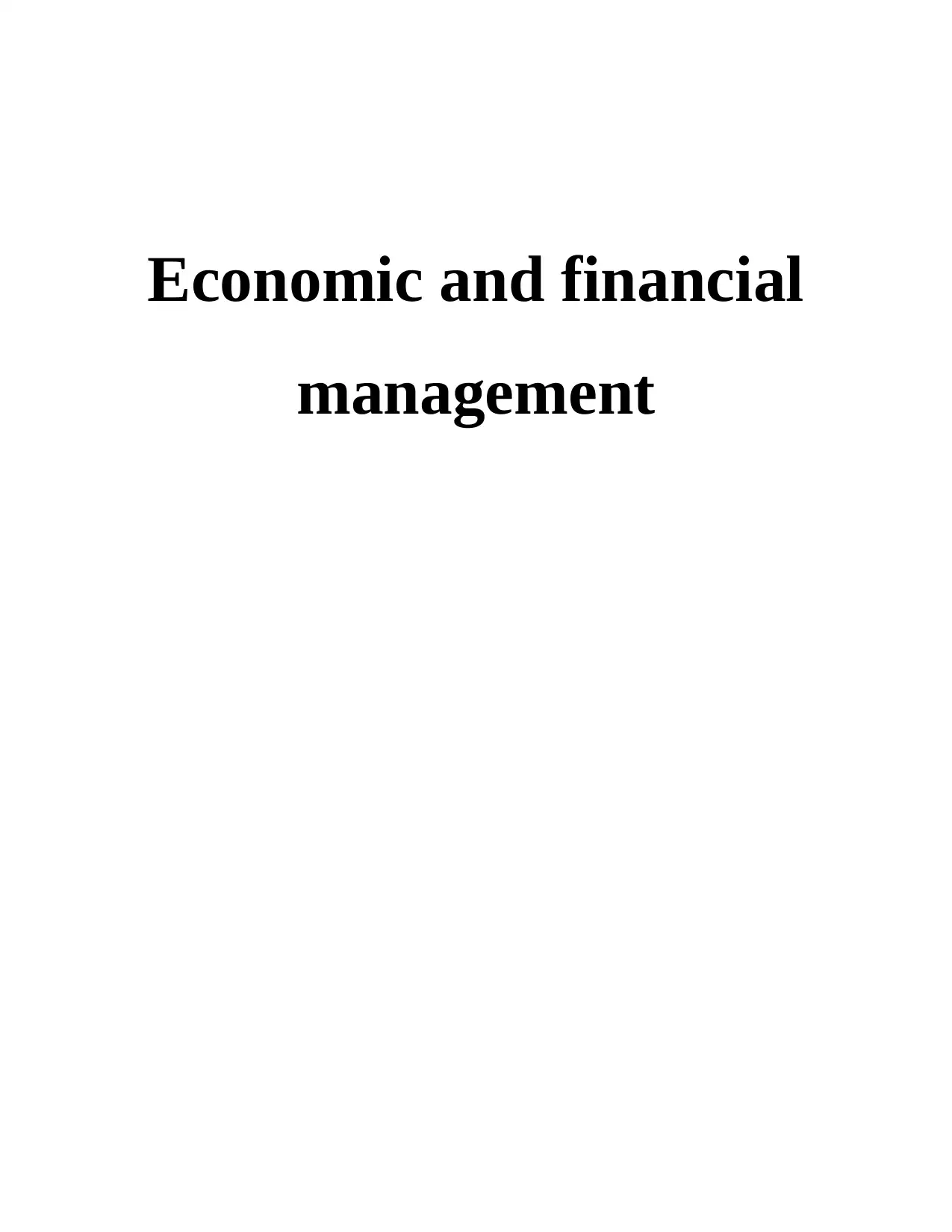
Economic and financial
management
management
Paraphrase This Document
Need a fresh take? Get an instant paraphrase of this document with our AI Paraphraser

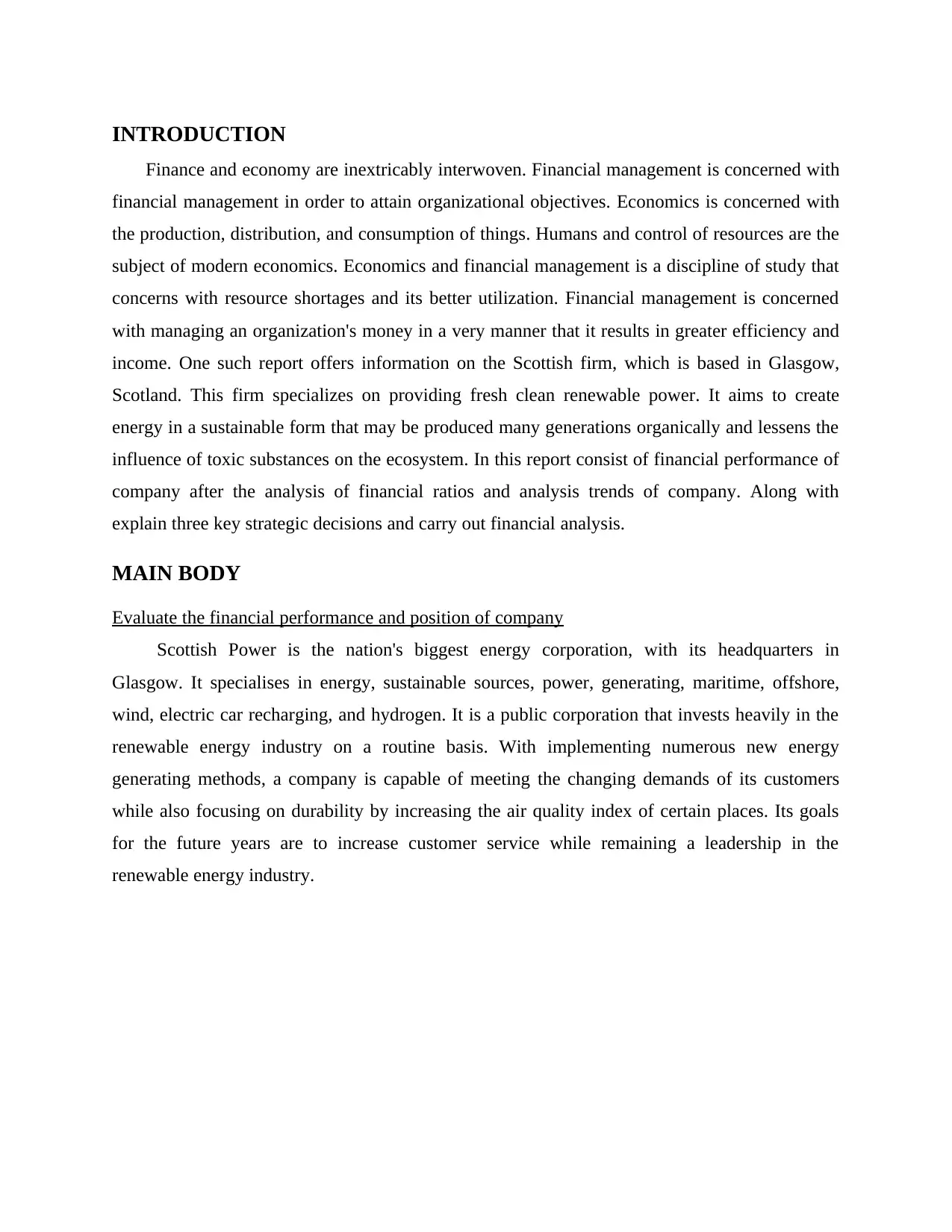
INTRODUCTION
Finance and economy are inextricably interwoven. Financial management is concerned with
financial management in order to attain organizational objectives. Economics is concerned with
the production, distribution, and consumption of things. Humans and control of resources are the
subject of modern economics. Economics and financial management is a discipline of study that
concerns with resource shortages and its better utilization. Financial management is concerned
with managing an organization's money in a very manner that it results in greater efficiency and
income. One such report offers information on the Scottish firm, which is based in Glasgow,
Scotland. This firm specializes on providing fresh clean renewable power. It aims to create
energy in a sustainable form that may be produced many generations organically and lessens the
influence of toxic substances on the ecosystem. In this report consist of financial performance of
company after the analysis of financial ratios and analysis trends of company. Along with
explain three key strategic decisions and carry out financial analysis.
MAIN BODY
Evaluate the financial performance and position of company
Scottish Power is the nation's biggest energy corporation, with its headquarters in
Glasgow. It specialises in energy, sustainable sources, power, generating, maritime, offshore,
wind, electric car recharging, and hydrogen. It is a public corporation that invests heavily in the
renewable energy industry on a routine basis. With implementing numerous new energy
generating methods, a company is capable of meeting the changing demands of its customers
while also focusing on durability by increasing the air quality index of certain places. Its goals
for the future years are to increase customer service while remaining a leadership in the
renewable energy industry.
Finance and economy are inextricably interwoven. Financial management is concerned with
financial management in order to attain organizational objectives. Economics is concerned with
the production, distribution, and consumption of things. Humans and control of resources are the
subject of modern economics. Economics and financial management is a discipline of study that
concerns with resource shortages and its better utilization. Financial management is concerned
with managing an organization's money in a very manner that it results in greater efficiency and
income. One such report offers information on the Scottish firm, which is based in Glasgow,
Scotland. This firm specializes on providing fresh clean renewable power. It aims to create
energy in a sustainable form that may be produced many generations organically and lessens the
influence of toxic substances on the ecosystem. In this report consist of financial performance of
company after the analysis of financial ratios and analysis trends of company. Along with
explain three key strategic decisions and carry out financial analysis.
MAIN BODY
Evaluate the financial performance and position of company
Scottish Power is the nation's biggest energy corporation, with its headquarters in
Glasgow. It specialises in energy, sustainable sources, power, generating, maritime, offshore,
wind, electric car recharging, and hydrogen. It is a public corporation that invests heavily in the
renewable energy industry on a routine basis. With implementing numerous new energy
generating methods, a company is capable of meeting the changing demands of its customers
while also focusing on durability by increasing the air quality index of certain places. Its goals
for the future years are to increase customer service while remaining a leadership in the
renewable energy industry.
⊘ This is a preview!⊘
Do you want full access?
Subscribe today to unlock all pages.

Trusted by 1+ million students worldwide
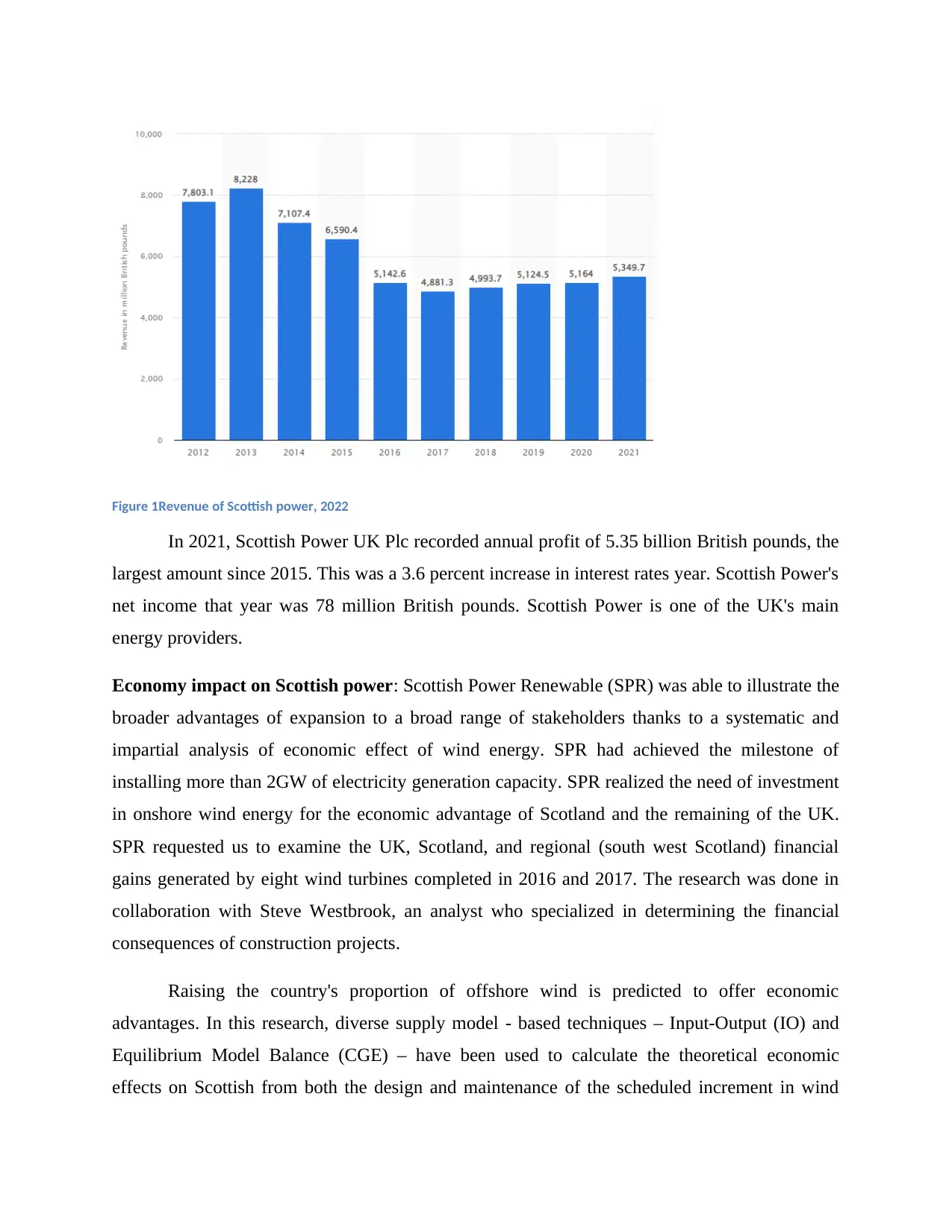
Figure 1Revenue of Scottish power, 2022
In 2021, Scottish Power UK Plc recorded annual profit of 5.35 billion British pounds, the
largest amount since 2015. This was a 3.6 percent increase in interest rates year. Scottish Power's
net income that year was 78 million British pounds. Scottish Power is one of the UK's main
energy providers.
Economy impact on Scottish power: Scottish Power Renewable (SPR) was able to illustrate the
broader advantages of expansion to a broad range of stakeholders thanks to a systematic and
impartial analysis of economic effect of wind energy. SPR had achieved the milestone of
installing more than 2GW of electricity generation capacity. SPR realized the need of investment
in onshore wind energy for the economic advantage of Scotland and the remaining of the UK.
SPR requested us to examine the UK, Scotland, and regional (south west Scotland) financial
gains generated by eight wind turbines completed in 2016 and 2017. The research was done in
collaboration with Steve Westbrook, an analyst who specialized in determining the financial
consequences of construction projects.
Raising the country's proportion of offshore wind is predicted to offer economic
advantages. In this research, diverse supply model - based techniques – Input-Output (IO) and
Equilibrium Model Balance (CGE) – have been used to calculate the theoretical economic
effects on Scottish from both the design and maintenance of the scheduled increment in wind
In 2021, Scottish Power UK Plc recorded annual profit of 5.35 billion British pounds, the
largest amount since 2015. This was a 3.6 percent increase in interest rates year. Scottish Power's
net income that year was 78 million British pounds. Scottish Power is one of the UK's main
energy providers.
Economy impact on Scottish power: Scottish Power Renewable (SPR) was able to illustrate the
broader advantages of expansion to a broad range of stakeholders thanks to a systematic and
impartial analysis of economic effect of wind energy. SPR had achieved the milestone of
installing more than 2GW of electricity generation capacity. SPR realized the need of investment
in onshore wind energy for the economic advantage of Scotland and the remaining of the UK.
SPR requested us to examine the UK, Scotland, and regional (south west Scotland) financial
gains generated by eight wind turbines completed in 2016 and 2017. The research was done in
collaboration with Steve Westbrook, an analyst who specialized in determining the financial
consequences of construction projects.
Raising the country's proportion of offshore wind is predicted to offer economic
advantages. In this research, diverse supply model - based techniques – Input-Output (IO) and
Equilibrium Model Balance (CGE) – have been used to calculate the theoretical economic
effects on Scottish from both the design and maintenance of the scheduled increment in wind
Paraphrase This Document
Need a fresh take? Get an instant paraphrase of this document with our AI Paraphraser
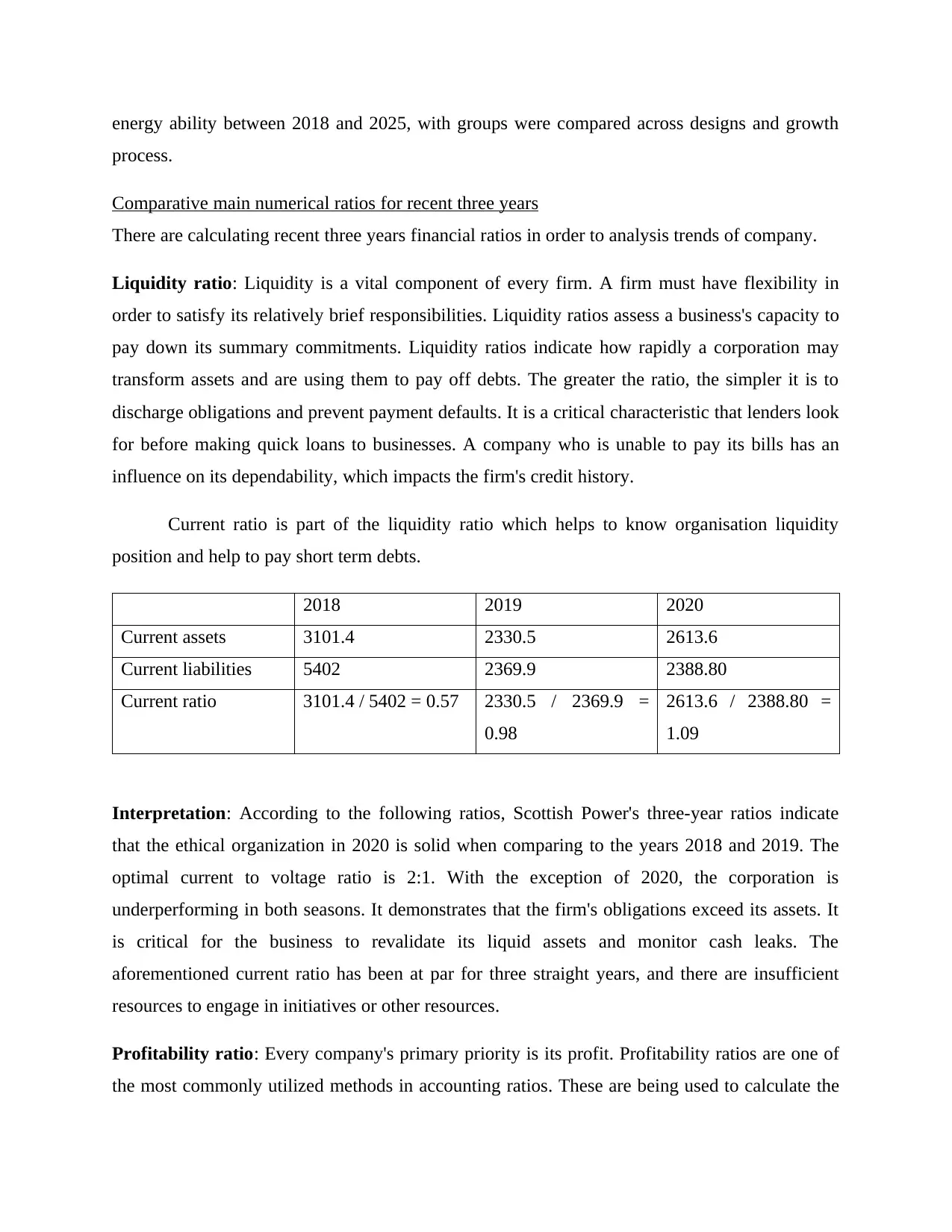
energy ability between 2018 and 2025, with groups were compared across designs and growth
process.
Comparative main numerical ratios for recent three years
There are calculating recent three years financial ratios in order to analysis trends of company.
Liquidity ratio: Liquidity is a vital component of every firm. A firm must have flexibility in
order to satisfy its relatively brief responsibilities. Liquidity ratios assess a business's capacity to
pay down its summary commitments. Liquidity ratios indicate how rapidly a corporation may
transform assets and are using them to pay off debts. The greater the ratio, the simpler it is to
discharge obligations and prevent payment defaults. It is a critical characteristic that lenders look
for before making quick loans to businesses. A company who is unable to pay its bills has an
influence on its dependability, which impacts the firm's credit history.
Current ratio is part of the liquidity ratio which helps to know organisation liquidity
position and help to pay short term debts.
2018 2019 2020
Current assets 3101.4 2330.5 2613.6
Current liabilities 5402 2369.9 2388.80
Current ratio 3101.4 / 5402 = 0.57 2330.5 / 2369.9 =
0.98
2613.6 / 2388.80 =
1.09
Interpretation: According to the following ratios, Scottish Power's three-year ratios indicate
that the ethical organization in 2020 is solid when comparing to the years 2018 and 2019. The
optimal current to voltage ratio is 2:1. With the exception of 2020, the corporation is
underperforming in both seasons. It demonstrates that the firm's obligations exceed its assets. It
is critical for the business to revalidate its liquid assets and monitor cash leaks. The
aforementioned current ratio has been at par for three straight years, and there are insufficient
resources to engage in initiatives or other resources.
Profitability ratio: Every company's primary priority is its profit. Profitability ratios are one of
the most commonly utilized methods in accounting ratios. These are being used to calculate the
process.
Comparative main numerical ratios for recent three years
There are calculating recent three years financial ratios in order to analysis trends of company.
Liquidity ratio: Liquidity is a vital component of every firm. A firm must have flexibility in
order to satisfy its relatively brief responsibilities. Liquidity ratios assess a business's capacity to
pay down its summary commitments. Liquidity ratios indicate how rapidly a corporation may
transform assets and are using them to pay off debts. The greater the ratio, the simpler it is to
discharge obligations and prevent payment defaults. It is a critical characteristic that lenders look
for before making quick loans to businesses. A company who is unable to pay its bills has an
influence on its dependability, which impacts the firm's credit history.
Current ratio is part of the liquidity ratio which helps to know organisation liquidity
position and help to pay short term debts.
2018 2019 2020
Current assets 3101.4 2330.5 2613.6
Current liabilities 5402 2369.9 2388.80
Current ratio 3101.4 / 5402 = 0.57 2330.5 / 2369.9 =
0.98
2613.6 / 2388.80 =
1.09
Interpretation: According to the following ratios, Scottish Power's three-year ratios indicate
that the ethical organization in 2020 is solid when comparing to the years 2018 and 2019. The
optimal current to voltage ratio is 2:1. With the exception of 2020, the corporation is
underperforming in both seasons. It demonstrates that the firm's obligations exceed its assets. It
is critical for the business to revalidate its liquid assets and monitor cash leaks. The
aforementioned current ratio has been at par for three straight years, and there are insufficient
resources to engage in initiatives or other resources.
Profitability ratio: Every company's primary priority is its profit. Profitability ratios are one of
the most commonly utilized methods in accounting ratios. These are being used to calculate the
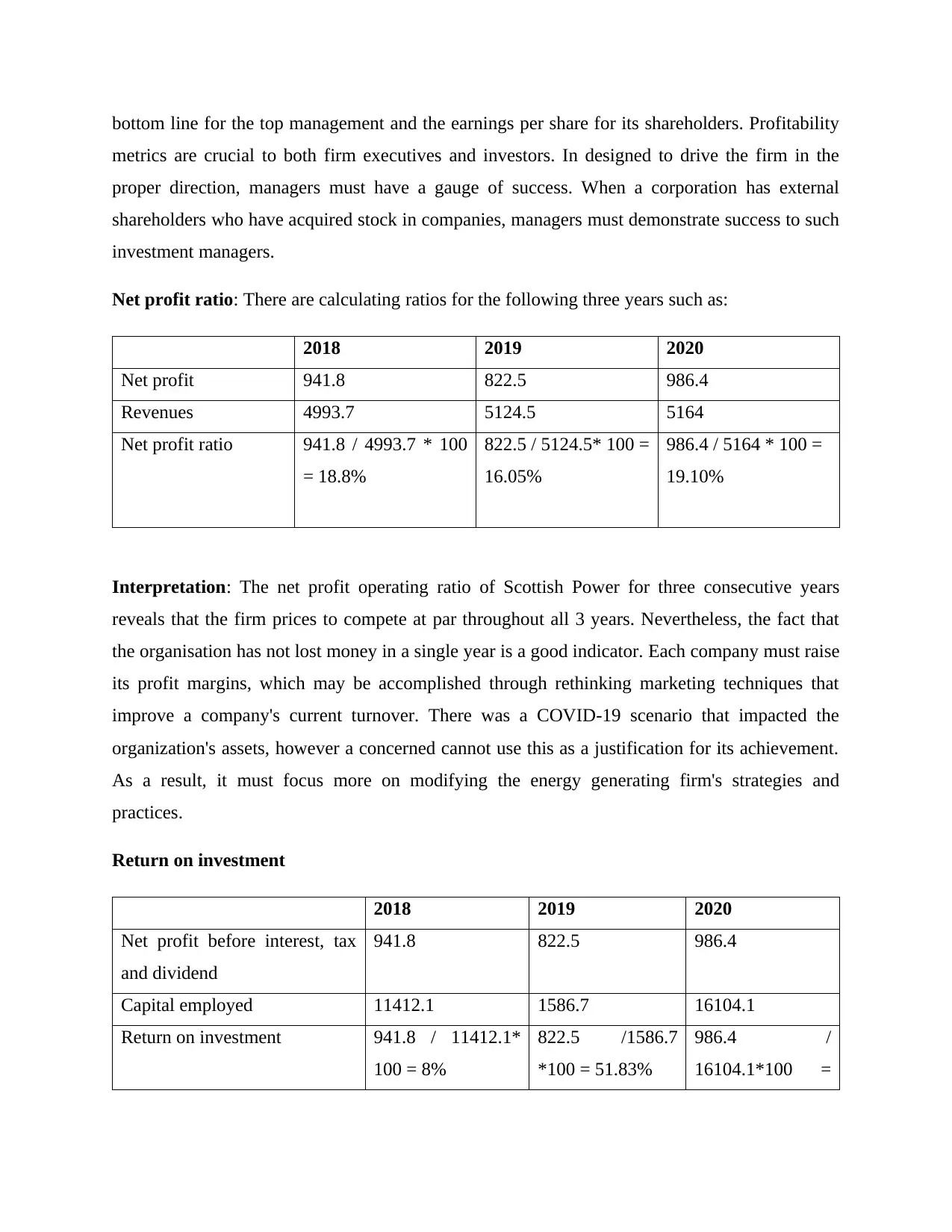
bottom line for the top management and the earnings per share for its shareholders. Profitability
metrics are crucial to both firm executives and investors. In designed to drive the firm in the
proper direction, managers must have a gauge of success. When a corporation has external
shareholders who have acquired stock in companies, managers must demonstrate success to such
investment managers.
Net profit ratio: There are calculating ratios for the following three years such as:
2018 2019 2020
Net profit 941.8 822.5 986.4
Revenues 4993.7 5124.5 5164
Net profit ratio 941.8 / 4993.7 * 100
= 18.8%
822.5 / 5124.5* 100 =
16.05%
986.4 / 5164 * 100 =
19.10%
Interpretation: The net profit operating ratio of Scottish Power for three consecutive years
reveals that the firm prices to compete at par throughout all 3 years. Nevertheless, the fact that
the organisation has not lost money in a single year is a good indicator. Each company must raise
its profit margins, which may be accomplished through rethinking marketing techniques that
improve a company's current turnover. There was a COVID-19 scenario that impacted the
organization's assets, however a concerned cannot use this as a justification for its achievement.
As a result, it must focus more on modifying the energy generating firm's strategies and
practices.
Return on investment
2018 2019 2020
Net profit before interest, tax
and dividend
941.8 822.5 986.4
Capital employed 11412.1 1586.7 16104.1
Return on investment 941.8 / 11412.1*
100 = 8%
822.5 /1586.7
*100 = 51.83%
986.4 /
16104.1*100 =
metrics are crucial to both firm executives and investors. In designed to drive the firm in the
proper direction, managers must have a gauge of success. When a corporation has external
shareholders who have acquired stock in companies, managers must demonstrate success to such
investment managers.
Net profit ratio: There are calculating ratios for the following three years such as:
2018 2019 2020
Net profit 941.8 822.5 986.4
Revenues 4993.7 5124.5 5164
Net profit ratio 941.8 / 4993.7 * 100
= 18.8%
822.5 / 5124.5* 100 =
16.05%
986.4 / 5164 * 100 =
19.10%
Interpretation: The net profit operating ratio of Scottish Power for three consecutive years
reveals that the firm prices to compete at par throughout all 3 years. Nevertheless, the fact that
the organisation has not lost money in a single year is a good indicator. Each company must raise
its profit margins, which may be accomplished through rethinking marketing techniques that
improve a company's current turnover. There was a COVID-19 scenario that impacted the
organization's assets, however a concerned cannot use this as a justification for its achievement.
As a result, it must focus more on modifying the energy generating firm's strategies and
practices.
Return on investment
2018 2019 2020
Net profit before interest, tax
and dividend
941.8 822.5 986.4
Capital employed 11412.1 1586.7 16104.1
Return on investment 941.8 / 11412.1*
100 = 8%
822.5 /1586.7
*100 = 51.83%
986.4 /
16104.1*100 =
⊘ This is a preview!⊘
Do you want full access?
Subscribe today to unlock all pages.

Trusted by 1+ million students worldwide
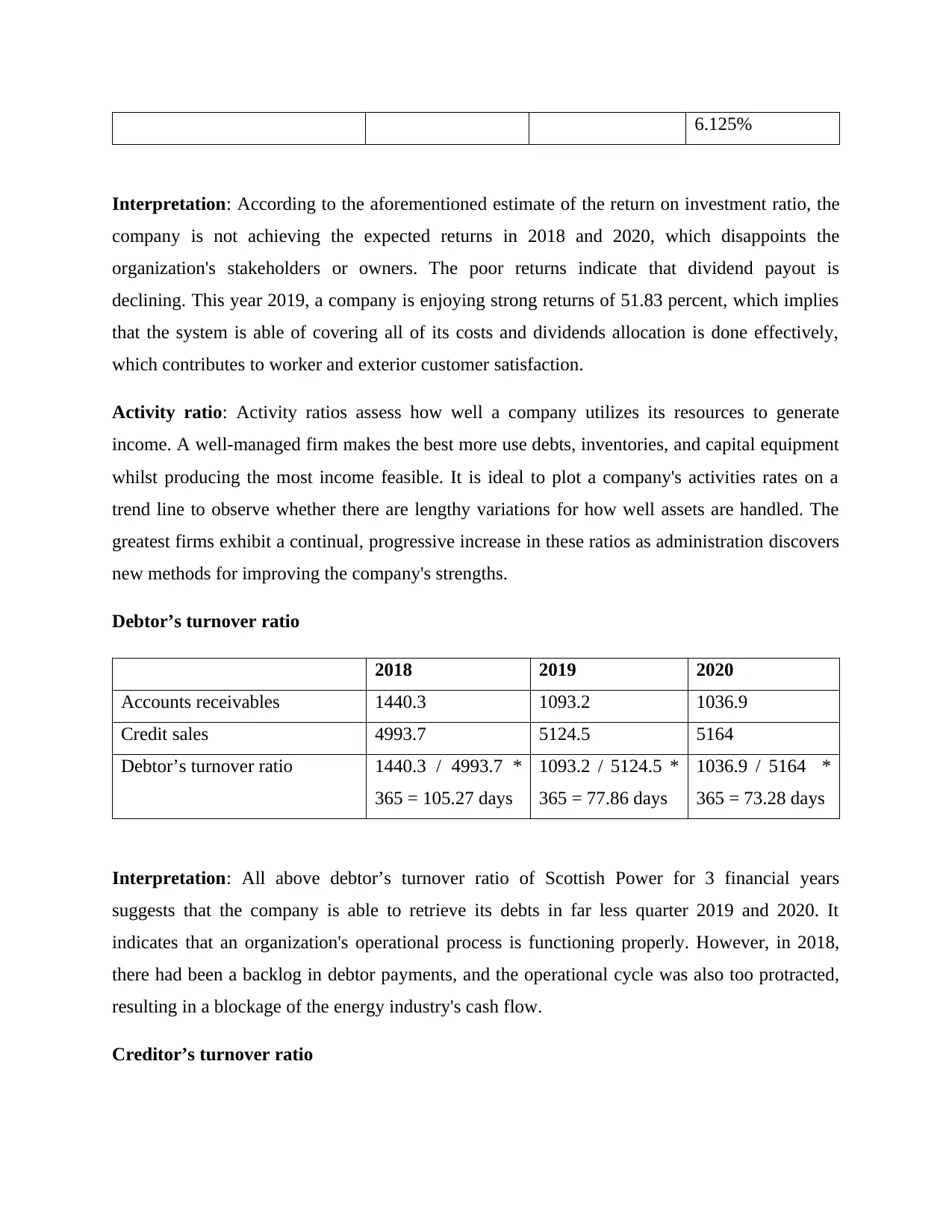
6.125%
Interpretation: According to the aforementioned estimate of the return on investment ratio, the
company is not achieving the expected returns in 2018 and 2020, which disappoints the
organization's stakeholders or owners. The poor returns indicate that dividend payout is
declining. This year 2019, a company is enjoying strong returns of 51.83 percent, which implies
that the system is able of covering all of its costs and dividends allocation is done effectively,
which contributes to worker and exterior customer satisfaction.
Activity ratio: Activity ratios assess how well a company utilizes its resources to generate
income. A well-managed firm makes the best more use debts, inventories, and capital equipment
whilst producing the most income feasible. It is ideal to plot a company's activities rates on a
trend line to observe whether there are lengthy variations for how well assets are handled. The
greatest firms exhibit a continual, progressive increase in these ratios as administration discovers
new methods for improving the company's strengths.
Debtor’s turnover ratio
2018 2019 2020
Accounts receivables 1440.3 1093.2 1036.9
Credit sales 4993.7 5124.5 5164
Debtor’s turnover ratio 1440.3 / 4993.7 *
365 = 105.27 days
1093.2 / 5124.5 *
365 = 77.86 days
1036.9 / 5164 *
365 = 73.28 days
Interpretation: All above debtor’s turnover ratio of Scottish Power for 3 financial years
suggests that the company is able to retrieve its debts in far less quarter 2019 and 2020. It
indicates that an organization's operational process is functioning properly. However, in 2018,
there had been a backlog in debtor payments, and the operational cycle was also too protracted,
resulting in a blockage of the energy industry's cash flow.
Creditor’s turnover ratio
Interpretation: According to the aforementioned estimate of the return on investment ratio, the
company is not achieving the expected returns in 2018 and 2020, which disappoints the
organization's stakeholders or owners. The poor returns indicate that dividend payout is
declining. This year 2019, a company is enjoying strong returns of 51.83 percent, which implies
that the system is able of covering all of its costs and dividends allocation is done effectively,
which contributes to worker and exterior customer satisfaction.
Activity ratio: Activity ratios assess how well a company utilizes its resources to generate
income. A well-managed firm makes the best more use debts, inventories, and capital equipment
whilst producing the most income feasible. It is ideal to plot a company's activities rates on a
trend line to observe whether there are lengthy variations for how well assets are handled. The
greatest firms exhibit a continual, progressive increase in these ratios as administration discovers
new methods for improving the company's strengths.
Debtor’s turnover ratio
2018 2019 2020
Accounts receivables 1440.3 1093.2 1036.9
Credit sales 4993.7 5124.5 5164
Debtor’s turnover ratio 1440.3 / 4993.7 *
365 = 105.27 days
1093.2 / 5124.5 *
365 = 77.86 days
1036.9 / 5164 *
365 = 73.28 days
Interpretation: All above debtor’s turnover ratio of Scottish Power for 3 financial years
suggests that the company is able to retrieve its debts in far less quarter 2019 and 2020. It
indicates that an organization's operational process is functioning properly. However, in 2018,
there had been a backlog in debtor payments, and the operational cycle was also too protracted,
resulting in a blockage of the energy industry's cash flow.
Creditor’s turnover ratio
Paraphrase This Document
Need a fresh take? Get an instant paraphrase of this document with our AI Paraphraser
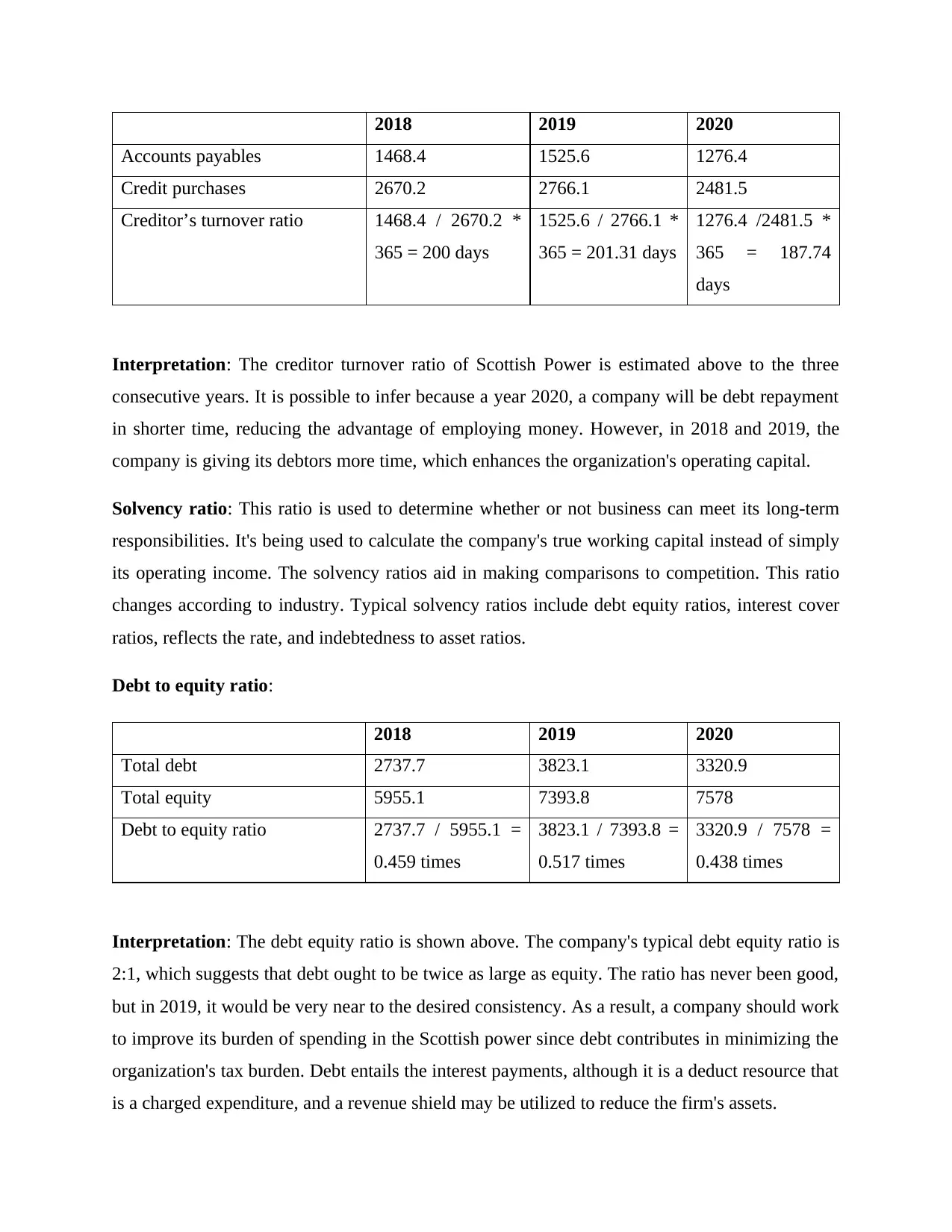
2018 2019 2020
Accounts payables 1468.4 1525.6 1276.4
Credit purchases 2670.2 2766.1 2481.5
Creditor’s turnover ratio 1468.4 / 2670.2 *
365 = 200 days
1525.6 / 2766.1 *
365 = 201.31 days
1276.4 /2481.5 *
365 = 187.74
days
Interpretation: The creditor turnover ratio of Scottish Power is estimated above to the three
consecutive years. It is possible to infer because a year 2020, a company will be debt repayment
in shorter time, reducing the advantage of employing money. However, in 2018 and 2019, the
company is giving its debtors more time, which enhances the organization's operating capital.
Solvency ratio: This ratio is used to determine whether or not business can meet its long-term
responsibilities. It's being used to calculate the company's true working capital instead of simply
its operating income. The solvency ratios aid in making comparisons to competition. This ratio
changes according to industry. Typical solvency ratios include debt equity ratios, interest cover
ratios, reflects the rate, and indebtedness to asset ratios.
Debt to equity ratio:
2018 2019 2020
Total debt 2737.7 3823.1 3320.9
Total equity 5955.1 7393.8 7578
Debt to equity ratio 2737.7 / 5955.1 =
0.459 times
3823.1 / 7393.8 =
0.517 times
3320.9 / 7578 =
0.438 times
Interpretation: The debt equity ratio is shown above. The company's typical debt equity ratio is
2:1, which suggests that debt ought to be twice as large as equity. The ratio has never been good,
but in 2019, it would be very near to the desired consistency. As a result, a company should work
to improve its burden of spending in the Scottish power since debt contributes in minimizing the
organization's tax burden. Debt entails the interest payments, although it is a deduct resource that
is a charged expenditure, and a revenue shield may be utilized to reduce the firm's assets.
Accounts payables 1468.4 1525.6 1276.4
Credit purchases 2670.2 2766.1 2481.5
Creditor’s turnover ratio 1468.4 / 2670.2 *
365 = 200 days
1525.6 / 2766.1 *
365 = 201.31 days
1276.4 /2481.5 *
365 = 187.74
days
Interpretation: The creditor turnover ratio of Scottish Power is estimated above to the three
consecutive years. It is possible to infer because a year 2020, a company will be debt repayment
in shorter time, reducing the advantage of employing money. However, in 2018 and 2019, the
company is giving its debtors more time, which enhances the organization's operating capital.
Solvency ratio: This ratio is used to determine whether or not business can meet its long-term
responsibilities. It's being used to calculate the company's true working capital instead of simply
its operating income. The solvency ratios aid in making comparisons to competition. This ratio
changes according to industry. Typical solvency ratios include debt equity ratios, interest cover
ratios, reflects the rate, and indebtedness to asset ratios.
Debt to equity ratio:
2018 2019 2020
Total debt 2737.7 3823.1 3320.9
Total equity 5955.1 7393.8 7578
Debt to equity ratio 2737.7 / 5955.1 =
0.459 times
3823.1 / 7393.8 =
0.517 times
3320.9 / 7578 =
0.438 times
Interpretation: The debt equity ratio is shown above. The company's typical debt equity ratio is
2:1, which suggests that debt ought to be twice as large as equity. The ratio has never been good,
but in 2019, it would be very near to the desired consistency. As a result, a company should work
to improve its burden of spending in the Scottish power since debt contributes in minimizing the
organization's tax burden. Debt entails the interest payments, although it is a deduct resource that
is a charged expenditure, and a revenue shield may be utilized to reduce the firm's assets.
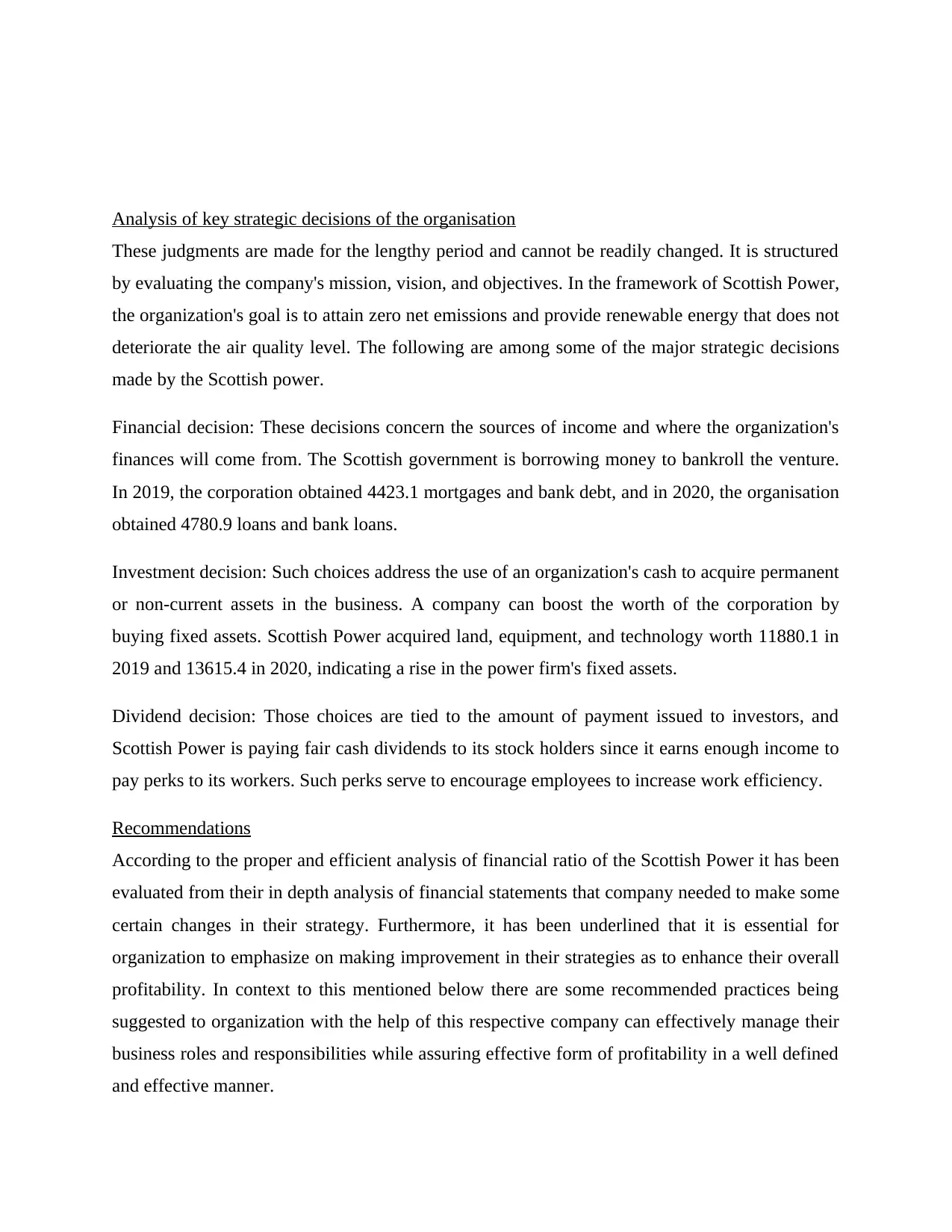
Analysis of key strategic decisions of the organisation
These judgments are made for the lengthy period and cannot be readily changed. It is structured
by evaluating the company's mission, vision, and objectives. In the framework of Scottish Power,
the organization's goal is to attain zero net emissions and provide renewable energy that does not
deteriorate the air quality level. The following are among some of the major strategic decisions
made by the Scottish power.
Financial decision: These decisions concern the sources of income and where the organization's
finances will come from. The Scottish government is borrowing money to bankroll the venture.
In 2019, the corporation obtained 4423.1 mortgages and bank debt, and in 2020, the organisation
obtained 4780.9 loans and bank loans.
Investment decision: Such choices address the use of an organization's cash to acquire permanent
or non-current assets in the business. A company can boost the worth of the corporation by
buying fixed assets. Scottish Power acquired land, equipment, and technology worth 11880.1 in
2019 and 13615.4 in 2020, indicating a rise in the power firm's fixed assets.
Dividend decision: Those choices are tied to the amount of payment issued to investors, and
Scottish Power is paying fair cash dividends to its stock holders since it earns enough income to
pay perks to its workers. Such perks serve to encourage employees to increase work efficiency.
Recommendations
According to the proper and efficient analysis of financial ratio of the Scottish Power it has been
evaluated from their in depth analysis of financial statements that company needed to make some
certain changes in their strategy. Furthermore, it has been underlined that it is essential for
organization to emphasize on making improvement in their strategies as to enhance their overall
profitability. In context to this mentioned below there are some recommended practices being
suggested to organization with the help of this respective company can effectively manage their
business roles and responsibilities while assuring effective form of profitability in a well defined
and effective manner.
These judgments are made for the lengthy period and cannot be readily changed. It is structured
by evaluating the company's mission, vision, and objectives. In the framework of Scottish Power,
the organization's goal is to attain zero net emissions and provide renewable energy that does not
deteriorate the air quality level. The following are among some of the major strategic decisions
made by the Scottish power.
Financial decision: These decisions concern the sources of income and where the organization's
finances will come from. The Scottish government is borrowing money to bankroll the venture.
In 2019, the corporation obtained 4423.1 mortgages and bank debt, and in 2020, the organisation
obtained 4780.9 loans and bank loans.
Investment decision: Such choices address the use of an organization's cash to acquire permanent
or non-current assets in the business. A company can boost the worth of the corporation by
buying fixed assets. Scottish Power acquired land, equipment, and technology worth 11880.1 in
2019 and 13615.4 in 2020, indicating a rise in the power firm's fixed assets.
Dividend decision: Those choices are tied to the amount of payment issued to investors, and
Scottish Power is paying fair cash dividends to its stock holders since it earns enough income to
pay perks to its workers. Such perks serve to encourage employees to increase work efficiency.
Recommendations
According to the proper and efficient analysis of financial ratio of the Scottish Power it has been
evaluated from their in depth analysis of financial statements that company needed to make some
certain changes in their strategy. Furthermore, it has been underlined that it is essential for
organization to emphasize on making improvement in their strategies as to enhance their overall
profitability. In context to this mentioned below there are some recommended practices being
suggested to organization with the help of this respective company can effectively manage their
business roles and responsibilities while assuring effective form of profitability in a well defined
and effective manner.
⊘ This is a preview!⊘
Do you want full access?
Subscribe today to unlock all pages.

Trusted by 1+ million students worldwide
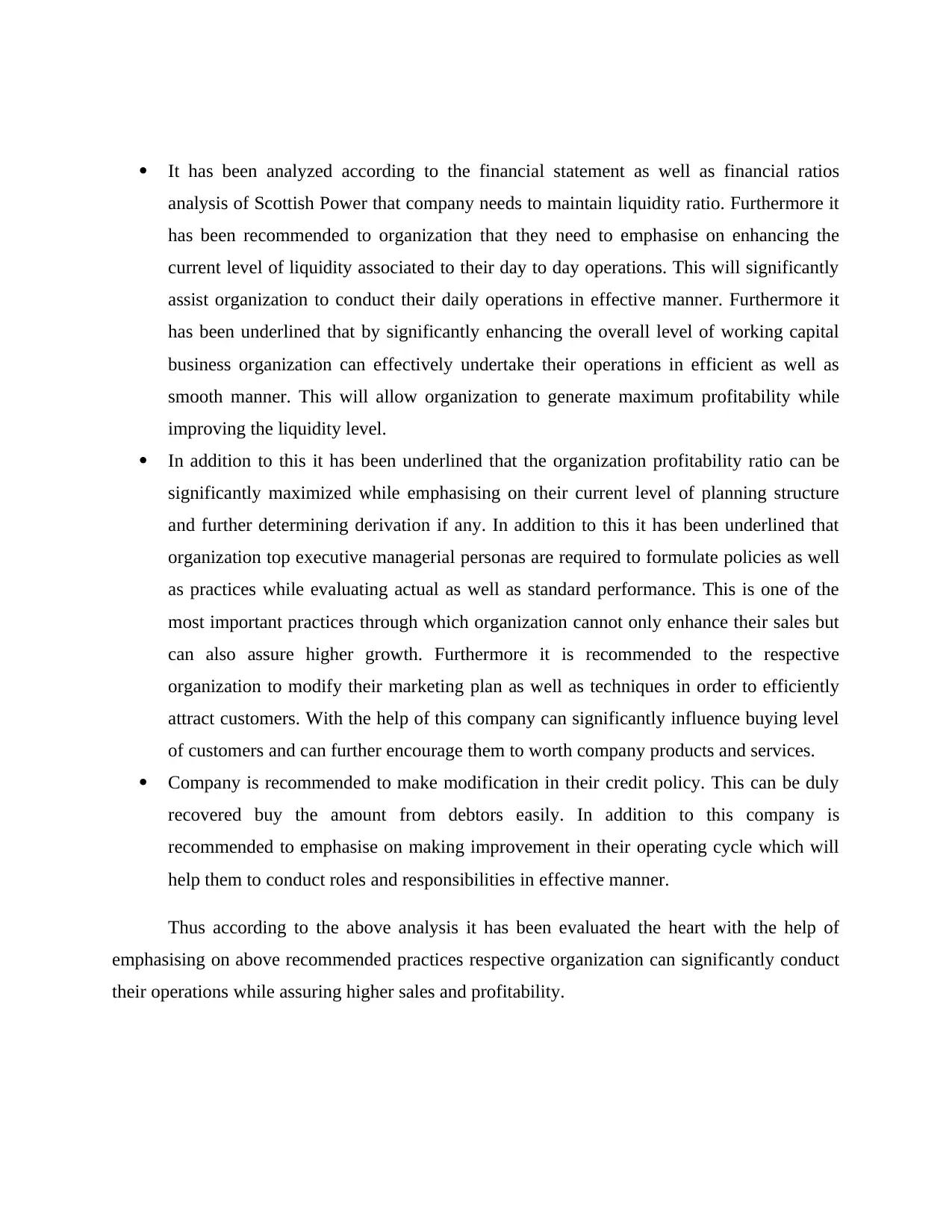
It has been analyzed according to the financial statement as well as financial ratios
analysis of Scottish Power that company needs to maintain liquidity ratio. Furthermore it
has been recommended to organization that they need to emphasise on enhancing the
current level of liquidity associated to their day to day operations. This will significantly
assist organization to conduct their daily operations in effective manner. Furthermore it
has been underlined that by significantly enhancing the overall level of working capital
business organization can effectively undertake their operations in efficient as well as
smooth manner. This will allow organization to generate maximum profitability while
improving the liquidity level.
In addition to this it has been underlined that the organization profitability ratio can be
significantly maximized while emphasising on their current level of planning structure
and further determining derivation if any. In addition to this it has been underlined that
organization top executive managerial personas are required to formulate policies as well
as practices while evaluating actual as well as standard performance. This is one of the
most important practices through which organization cannot only enhance their sales but
can also assure higher growth. Furthermore it is recommended to the respective
organization to modify their marketing plan as well as techniques in order to efficiently
attract customers. With the help of this company can significantly influence buying level
of customers and can further encourage them to worth company products and services.
Company is recommended to make modification in their credit policy. This can be duly
recovered buy the amount from debtors easily. In addition to this company is
recommended to emphasise on making improvement in their operating cycle which will
help them to conduct roles and responsibilities in effective manner.
Thus according to the above analysis it has been evaluated the heart with the help of
emphasising on above recommended practices respective organization can significantly conduct
their operations while assuring higher sales and profitability.
analysis of Scottish Power that company needs to maintain liquidity ratio. Furthermore it
has been recommended to organization that they need to emphasise on enhancing the
current level of liquidity associated to their day to day operations. This will significantly
assist organization to conduct their daily operations in effective manner. Furthermore it
has been underlined that by significantly enhancing the overall level of working capital
business organization can effectively undertake their operations in efficient as well as
smooth manner. This will allow organization to generate maximum profitability while
improving the liquidity level.
In addition to this it has been underlined that the organization profitability ratio can be
significantly maximized while emphasising on their current level of planning structure
and further determining derivation if any. In addition to this it has been underlined that
organization top executive managerial personas are required to formulate policies as well
as practices while evaluating actual as well as standard performance. This is one of the
most important practices through which organization cannot only enhance their sales but
can also assure higher growth. Furthermore it is recommended to the respective
organization to modify their marketing plan as well as techniques in order to efficiently
attract customers. With the help of this company can significantly influence buying level
of customers and can further encourage them to worth company products and services.
Company is recommended to make modification in their credit policy. This can be duly
recovered buy the amount from debtors easily. In addition to this company is
recommended to emphasise on making improvement in their operating cycle which will
help them to conduct roles and responsibilities in effective manner.
Thus according to the above analysis it has been evaluated the heart with the help of
emphasising on above recommended practices respective organization can significantly conduct
their operations while assuring higher sales and profitability.
Paraphrase This Document
Need a fresh take? Get an instant paraphrase of this document with our AI Paraphraser
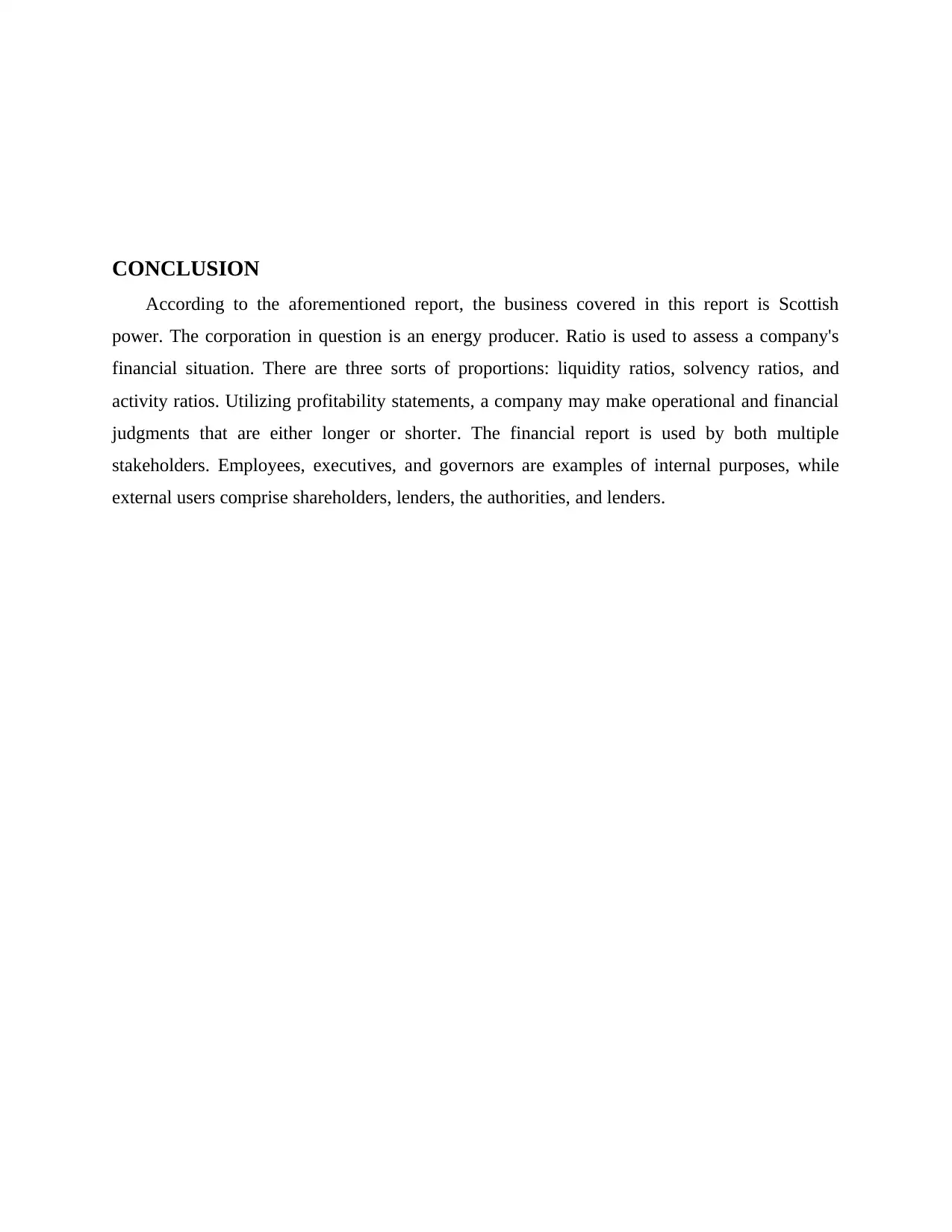
CONCLUSION
According to the aforementioned report, the business covered in this report is Scottish
power. The corporation in question is an energy producer. Ratio is used to assess a company's
financial situation. There are three sorts of proportions: liquidity ratios, solvency ratios, and
activity ratios. Utilizing profitability statements, a company may make operational and financial
judgments that are either longer or shorter. The financial report is used by both multiple
stakeholders. Employees, executives, and governors are examples of internal purposes, while
external users comprise shareholders, lenders, the authorities, and lenders.
According to the aforementioned report, the business covered in this report is Scottish
power. The corporation in question is an energy producer. Ratio is used to assess a company's
financial situation. There are three sorts of proportions: liquidity ratios, solvency ratios, and
activity ratios. Utilizing profitability statements, a company may make operational and financial
judgments that are either longer or shorter. The financial report is used by both multiple
stakeholders. Employees, executives, and governors are examples of internal purposes, while
external users comprise shareholders, lenders, the authorities, and lenders.
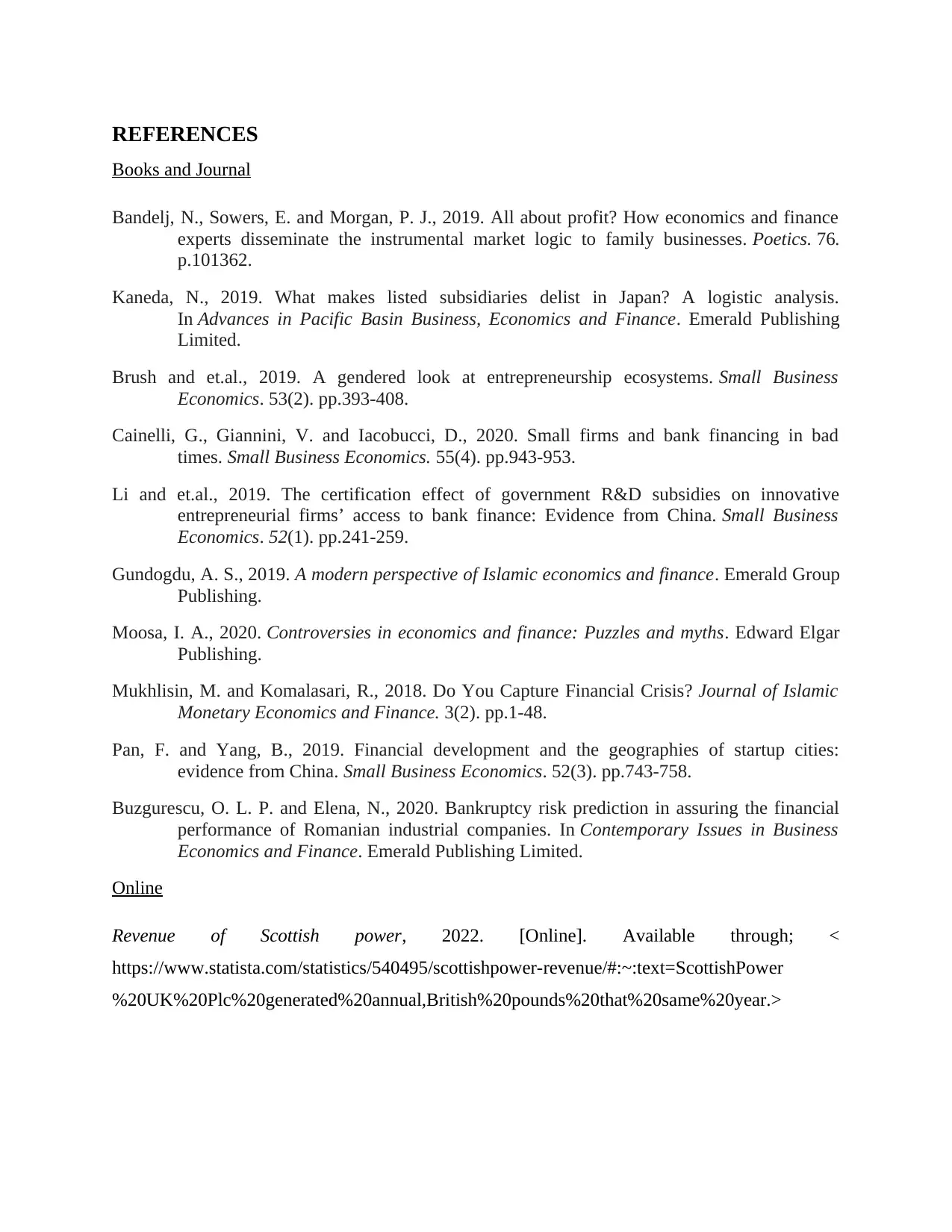
REFERENCES
Books and Journal
Bandelj, N., Sowers, E. and Morgan, P. J., 2019. All about profit? How economics and finance
experts disseminate the instrumental market logic to family businesses. Poetics. 76.
p.101362.
Kaneda, N., 2019. What makes listed subsidiaries delist in Japan? A logistic analysis.
In Advances in Pacific Basin Business, Economics and Finance. Emerald Publishing
Limited.
Brush and et.al., 2019. A gendered look at entrepreneurship ecosystems. Small Business
Economics. 53(2). pp.393-408.
Cainelli, G., Giannini, V. and Iacobucci, D., 2020. Small firms and bank financing in bad
times. Small Business Economics. 55(4). pp.943-953.
Li and et.al., 2019. The certification effect of government R&D subsidies on innovative
entrepreneurial firms’ access to bank finance: Evidence from China. Small Business
Economics. 52(1). pp.241-259.
Gundogdu, A. S., 2019. A modern perspective of Islamic economics and finance. Emerald Group
Publishing.
Moosa, I. A., 2020. Controversies in economics and finance: Puzzles and myths. Edward Elgar
Publishing.
Mukhlisin, M. and Komalasari, R., 2018. Do You Capture Financial Crisis? Journal of Islamic
Monetary Economics and Finance. 3(2). pp.1-48.
Pan, F. and Yang, B., 2019. Financial development and the geographies of startup cities:
evidence from China. Small Business Economics. 52(3). pp.743-758.
Buzgurescu, O. L. P. and Elena, N., 2020. Bankruptcy risk prediction in assuring the financial
performance of Romanian industrial companies. In Contemporary Issues in Business
Economics and Finance. Emerald Publishing Limited.
Online
Revenue of Scottish power, 2022. [Online]. Available through; <
https://www.statista.com/statistics/540495/scottishpower-revenue/#:~:text=ScottishPower
%20UK%20Plc%20generated%20annual,British%20pounds%20that%20same%20year.>
Books and Journal
Bandelj, N., Sowers, E. and Morgan, P. J., 2019. All about profit? How economics and finance
experts disseminate the instrumental market logic to family businesses. Poetics. 76.
p.101362.
Kaneda, N., 2019. What makes listed subsidiaries delist in Japan? A logistic analysis.
In Advances in Pacific Basin Business, Economics and Finance. Emerald Publishing
Limited.
Brush and et.al., 2019. A gendered look at entrepreneurship ecosystems. Small Business
Economics. 53(2). pp.393-408.
Cainelli, G., Giannini, V. and Iacobucci, D., 2020. Small firms and bank financing in bad
times. Small Business Economics. 55(4). pp.943-953.
Li and et.al., 2019. The certification effect of government R&D subsidies on innovative
entrepreneurial firms’ access to bank finance: Evidence from China. Small Business
Economics. 52(1). pp.241-259.
Gundogdu, A. S., 2019. A modern perspective of Islamic economics and finance. Emerald Group
Publishing.
Moosa, I. A., 2020. Controversies in economics and finance: Puzzles and myths. Edward Elgar
Publishing.
Mukhlisin, M. and Komalasari, R., 2018. Do You Capture Financial Crisis? Journal of Islamic
Monetary Economics and Finance. 3(2). pp.1-48.
Pan, F. and Yang, B., 2019. Financial development and the geographies of startup cities:
evidence from China. Small Business Economics. 52(3). pp.743-758.
Buzgurescu, O. L. P. and Elena, N., 2020. Bankruptcy risk prediction in assuring the financial
performance of Romanian industrial companies. In Contemporary Issues in Business
Economics and Finance. Emerald Publishing Limited.
Online
Revenue of Scottish power, 2022. [Online]. Available through; <
https://www.statista.com/statistics/540495/scottishpower-revenue/#:~:text=ScottishPower
%20UK%20Plc%20generated%20annual,British%20pounds%20that%20same%20year.>
⊘ This is a preview!⊘
Do you want full access?
Subscribe today to unlock all pages.

Trusted by 1+ million students worldwide
1 out of 12
Related Documents
Your All-in-One AI-Powered Toolkit for Academic Success.
+13062052269
info@desklib.com
Available 24*7 on WhatsApp / Email
![[object Object]](/_next/static/media/star-bottom.7253800d.svg)
Unlock your academic potential
Copyright © 2020–2025 A2Z Services. All Rights Reserved. Developed and managed by ZUCOL.





